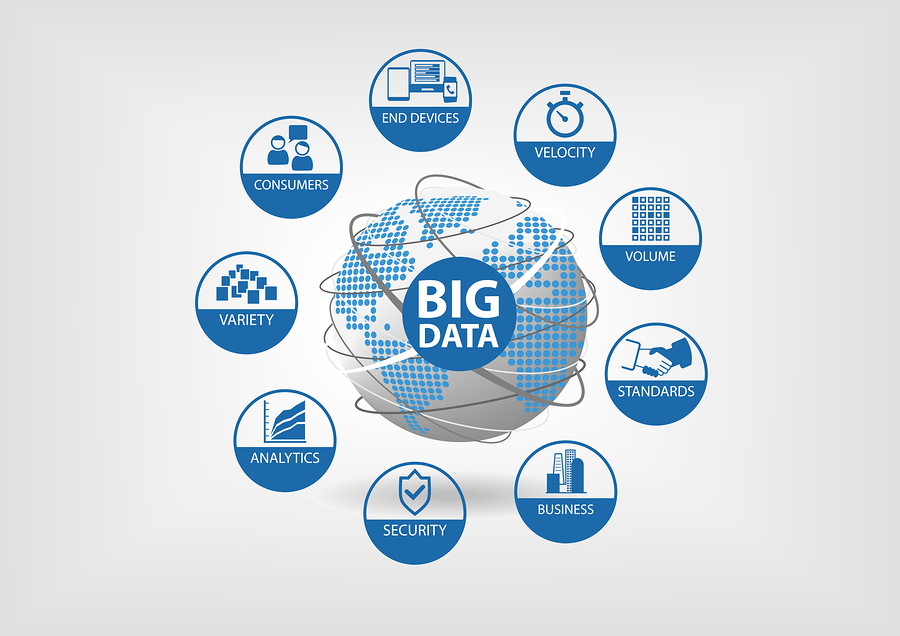In the world of business intelligence, big data and data lakes can be crucial to success. And, as computers develop more and more storage and retrieval capacity, the sky is the limit with the amount of information gathered.
As more businesses use more data, the ones that don’t will be left behind.
What is Big Data?
The definition of the term “big data” is hinted at by its name. Data refers to information (typically in a digital format). Here, we’re talking about “big” data as opposed to “little” or “small data.”
As you might have guessed, big data, on a technical level, refers to extremely large collections of information that are very complex and require extra computing power and memory to access.
“Big data is a term for data sets that are so large or complex that traditional data processing applications are inadequate. Challenges include analysis, capture, data curation, search, sharing, storage, transfer, visualization, querying and information privacy.”
The term big data has also expanded to refer to how that large amount of data is used. This includes applications such as business intelligence, predicting user behavior, or machine learning, which is used to develop AI applications.
Big data analytics are becoming more and more important in the field of business intelligence (BI). BI involves the development and implementation of strategies to leverage data analysis to support decision making and solve business problems.
A big data expert is someone who is adept at using big data tools to analyze the vast information stored and make sense of it for stakeholders and decision-makers such as managers and executives.
More and more companies, such as Cloud Big Data Technologies LLC, are offering big data services, from business analysis to data storage and retrieval.
What is a Data Lake?
In the world of big data, systems analysts have come up with various ways of organizing, storing, and retrieving data. Traditionally, computer data has tended to be parsed and organized before it goes into a database. This is not only to save space on the hard drive, but to improve processing speed.
In a traditional database running on a platform such as MySQL, more data can put a strain on the system. If a database becomes too large for the computer processor to handle, it can slow data queries and hang programs.
Optimizing data – which might include culling data that is no longer needed – then becomes crucial for database tuning and performance.
The idea behind a “data lake” is that you take all the data you have and keep it, often in its original format. Unlike in a more traditional database, a data lake might actually incorporate large binary files such as videos, PDFs, other types of documents.
A data lake might also interface with a more traditional set of data put in a more traditional relational database format.
Data lakes have a strong association with Hadoop, an open source, object-oriented Java framework used for processing big data. However, data lakes can be created and accessed on other types of platforms as well.
The benefits of data lakes are that you have lots of data to access, and you have the opportunity to apply it in various creative ways. It unshackles the business intelligence analyst from restrictions and limitations, engendering innovative and unique ways to explore data.
The Challenges of Data Lakes
 As big data on cloud computing becomes more and more popular, more companies are turning to data lakes. Storage is now cheaper than ever, and with companies like Amazon in the big data storage business, businesses don’t have to worry about managing their own database servers.
As big data on cloud computing becomes more and more popular, more companies are turning to data lakes. Storage is now cheaper than ever, and with companies like Amazon in the big data storage business, businesses don’t have to worry about managing their own database servers.
Yet, data lakes should not be the first go-to for a business. They should only be implemented with careful analysis and planning.
Data Swamps and Data Graveyards
The biggest danger of a data lake is that, without planning, the data becomes simply inaccessible. A data lake that has become a technological bog, where data is so jam-packed without any organization that it becomes unusable, is called a data swamp.
Or, a company might just dump all their information into one big data black hole, thinking, “Well, we’ll use this eventually.”
The data ends up just sitting there, gathering virtual dust. Such data lakes are the equivalent of data graveyards. They are where data goes to die.
Data that is not being used is simply dead data.
In the Future, All Businesses May Need Big Data
Big data and data lakes, are, as you might have guessed from the “large” aspect of it all, something that larger companies can benefit the most from. However, in the not-so-distant future, even small businesses may have ways to access and utilize big data in order to help grow their business. As they say, information is power.

